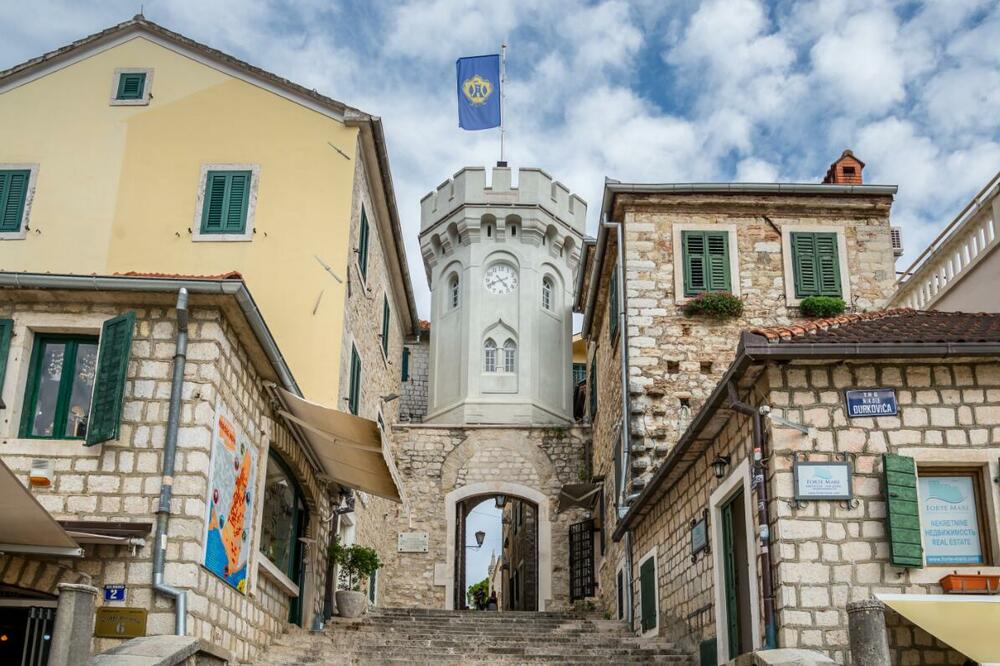SQUARE - TVRTKO
The monument to King Tvrtko I Kotromanich is placed here symbolically, at the entrance to the city from the sea, from the exit from the bay to the world from where it is captured or from which it looks to the future. The vision of Tvrtko has disappeared and belongs to history, but that part of the history that exists and lives in us, and only us, and not in the world around us. We want this monument to remain synonymous of the fate of our city, the feeling that it is at home, between its own, a synonymous safe haven, belonging and support, a place where everyone can always find their home. The monu - ment to the founder of the city, King Tvrtko I Kotroman - ich was created as a symbol of disobedience and love, awakening and twilight, a clash of the touching past and the gloom of the present, the border of the end and infinity, and proof that real values do not have an alterna - tive. And let’s keep it in the name of pride and an answer to the question of the old philosopher, how little of the childhood dreams an adult reaches.
MIMOSA FESTIVAL
The Mimosa Festival is an event celebrating mimosa that blooms and spreads its fragrance across Herceg Novi when almost the entire Europe is covered in snow. This holiday is based on the traditional carnival celebrations typical for coastal regions like ours, and every year, it offers more and more pro - grams for tourists, and entertaining, cultural, sports, and other events. The brass band music on the streets for the duration of the Festival, and performanc - es of young Novians, majorettes and mask performers create a unique picture of a mass pubic celebration. This most important travel and promotional event, the Mimosa Festival, lasts throughout February.

HERCEG NOVI FILM FESTIVAL – MONTENEGRO FILM FESTIVAL
With over three-decade-old tradition, the Herceg Novi Film Festival – Montene - gro Film Festival – takes place in the first week of August on the fortresses Kan - li Kula and Forte Mare, and on the Mica Pavlovica Square. This is the most impor - tant cultural event in Montenegro and it shows films from the entire world, com - plementing the travel offers of the city and welcoming lovers of the seventh art with a promise of enjoyment in open-air projections in a beautiful ambient. The open-air cinema on Kanli Kula is desig - nated for feature-length films, the Music Square offers documentaries in the Old Town, and the program also includes student-made films as Festival winners that are shown on Forte Mare.
CITADELA
Citadela (Matsel-Mezzaluna) was built on the very seashore, so that its southern walls were at sea. In 1702, Peter Angelo Mango united the upper part of the Lower city with a strong wall with the Citadel, and therefore the whole city was covered with thick walls, as evidenced by the inscription near the Capuchin monastery (today St. Leopold). The Citadel with fortress Forte Mara has a main defensive character as a fortress by the sea, and a tower with walls built during various invaders. It is in its foundations that the beginning of Herceg Novi should be sought. It also includes a stone bridge above the present embankment. With the existing project, this fort could be restored to its original state, especially because fragments of destroyed walls were preserved around its founda - tion. The citadel was destroyed during the last earthquake of 1979, which was fatal for it, it collapsed into the sea.
MAMULA ISLAND
The island is known on the sea maps as the “Lastavica” island. It acquired its widely accepted name “Mamula” after the Austrian general Lazar Mamula who fortified it in the mid-19th century. Mamu - la is an uninhabited island located at the entrance to the Bay of Kotor, 3.4 nm from Herceg Novi. It is circular, 200 m in diame - ter. It is covered with low vegetation, it has a beach and a dock on its Northern side. During the both World Wars, there was a prison on the island and nowadays there is a commemorative inscription reminiscent of that period. Mamula continues to be an abandoned island, but also a favourite summer getaway.

FORTE MARE (SEA FORTRESS)
Sea Fortress was built in the period between the 14th and 17th century, reconstructed in 1833, from 1952 turned into a summer movie theatre, and later into a discotheque. The fortress rests on strong rocks, placed above the walkway along the coast, and, inside its walls, there is a door - a passage leading from the coast to the top of the fortress. On the upper side of the fortress, there is a “Porta di mare” (Sea Door) with rudiments from the Bosnian period. Forte Mare Fortress is open to individual and group visits every day from 9:00 am to 8:00 pm. A ticket for individual visits is 2€, while for the group ones it is 1€.
ST. JEROME CHURCH
It is located in the Old City, on the lower square - the Mico Pavlovic Square. It was built in 1856. In the 17th century, on the same location, there was a Catholic parochial church dedicated to St. Jerome (Sv. Jeronim), the protector of the city. That church was torn down in the 19th century, and the present church, a much more spacious one, was built on the same location. This church holds the works of one of the greatest baroque painters - Tripo Kokolja from Perast.
CITY MUSEUM “MIRKO KOMNENOVIC”
The City Museum Mirko Komnenovic was founded as the National Museum in 1949 and opened for the public as the Heritage Museum in 1953. It was founded by Mirko and Olga Komnenovic. The museum contains archaeological, ethnological and historical collection, as well as a collection of stone monuments. During the summer, the museum is open for visitors from Friday to Saturday from 8:00am to 8:00pm. In winter from Monday do Suturday from 9:00am to 5:00pm. A price for a ticket for adults is 3€, and for children 1€. For groups of more than 5 persons, the price is 2€.
CHURCH OF THE HOLY SALVATION
The Church of the Savior is in Topla. The construction of this church began in 1709, next to the church of St. George, and the construction of the church was completed in 1713. It received its present appearance in 1864, when it was reconstructed almost from the basement. Inside the church there are extremely valuable items that were given to this church by famous people of that time. Above this and the church of St. George - this parish cemetery together with the cemetery of cells (with a memorial plaque), in which Josip Tropovich taught Peter Petrovich Nyegosh.
SPANJOLA
A fortress that started being built during the Turkish rule in 15th century. However, its current name originated from the Spanish conquerors who renovated it and continued its construction during their one-year rule over the city. Its original name was the “Upper City” Fortress. Its present appearance was acquired during the Turkish rule in 16th century. It is located at the North-western side of the city on the Bajer hill, at the height of 17 meters.

ST. ARHANGEL MIHAILO CHURCH ILINICA
It dominates on the upper side of the town square called Belavista. It was built in the shape of a Greek cross with identical arms, made from finely carved stone from Korcula. It also has some Bysantic, Romano-Gothic and Islamic elements in the structure, all very eclectic and creative. Although only recently, the church fits perfectly in the ambient of the Old Town. The Icon in white Italian marble made by Pavle Bilinic looks very impressive thus placed on the inside wall of the church.

TITO’S VILA
As a part of Institute Igalo, there is a facility that once belonged to lifetime president of SFRY, Josip Broz Tito. This facility is known as Villa “Galeb”. It was built back in 1976. The President resided in there four times during his official visit. Visitors will be able to see the places where Tito used to reside, organize the meetings, watch movies, with his co-workers and guests. Visitors will be able to see Tito’s and Jovanka’s apartment, which is at the same time the most exclusive part of the Villa.
ILINICA
In Ilinica, over the village of Zhvynje in the municipality of Herceg Novi, next to the church of St. Elijah, there is a monument to the French soldiers who fell during the reign of Napoleon in Boka Kotorska. In their honor the French soldiers built a monument in 1919 in free translation ‘Thessaloniki soldiers’ who were found here after the liberation of Montenegro and Boki.
CLOCK TOWER
The Clock Tower was built in 1667 at the order of Sultan Mahmud. During the Turkish rule, it represented the main city gates. There is a sculpture of Madonna in its arcade (called the “Black Madonna” since it was built from the burnt wood), in remembrance of the founder of the city, Tvrtko I Kotromanic, and was made in a form of bas-relief by Afran Hodzic from Sarajevo. The clock on the tower was replaced by an electric one only in 1995 and it was a gift from the city of Zemun.
CLOISTER SAVINA
The entrance into the cloister’s courtyard is lined with more than 200 years old ornate cypresses and pine trees. The complex consists of small and large church of the Rising of Our Lady, the Treasury and St. Sava church on the lookout above. The small church houses the oldest found murals in these areas, which are presumed to be made by the Kotor’s artist Lovro Marinov Dobricevic, one of the renown seaside masters of 15th century. The iconography and the styles mixture of different cultures and traditions make the murals of Savina unique.
CITY GALLERY JOSIP BEPO BENKOVIC
On the day December 15, 1966, after the closing of the Art School in Herceg Novi, artists and citizens of good will founded an art gallery that gets name by the artist Josip Bepo Benkovic. This year was taken as the year of foundation of the gallery, which practically began to work with organizing The First Winter Art Salon of Herceg Novi in February 1968. The salon of Herceg Novi continued to last to the present day and it represents an unique section of contemporary fine art. Gallery “Josip Bepo Benkovic” organizes a big number of exhibitions of the artists from Montenegro and abroad.
THE HOME OF IVO ANDRIĆ
“The Ivo Andrić House is a multicultural center that additionally sheds new light on Herceg Novi as a city of artists, art and a rich cultural heritage.” Andrich’s conviction in “a decent life, in accordance with the time you’re living in” was taken to carry out project activities. Thus, the goal was to create the Ivo Andrić House as a place of memory, as well as for cultural programs that unite educational and cultural institutions, organizations and individuals in the country and beyond. An important part of the complex is the garden, which Andrich devoted special attention to. According to the testimony of his contemporaries and writer’s records, it was here that he and his wife Militsa Babich experienced personal harmony, making it unique in the world. The garden was restored by landscape architects and horticultural specialists in accordance with the list of plants made by the writer
KANLI KULA (BLOODY TOWER)
Originates from the Turkish period (16th century); it used to be a prison (which is where its original Turkish name - the “Bloody Tower” comes from), and in 1966 it was reconstructed and turned into one of the most wonderful summer stages on the Adriatic coast, which has over 1000 seats, even though it can accommodate over the total number of 1500 persons. On the south walls of the fortress, there is the so-called “Donkey door”, which was made by Austrians in the 19th century. Kanli Kula Fortress is open to individual and group visits every day from 9:00 am to 9:00 pm. A ticket for individual visits is 2€, while for the group ones it is 1€

ST. LEOPOLD MANDIC CHURCH
Upon the liberation of the city from the Turks, the Venetians built a convent in 1688, and a small church adjacent to it, dedicated to Holy Virgin Mary. Later on, the church was dedicated to St. Franjo, and recently, more precisely in 1976, it was dedicated to St. Leopold Bogdan Mandic, who was born in Herceg Novi and proclaimed a saint in 1983 by the Pope John Paul II
Bonus video:





